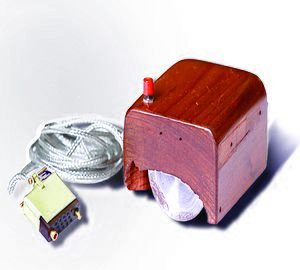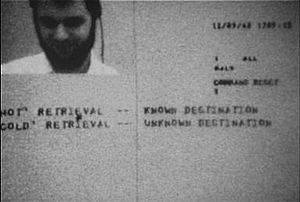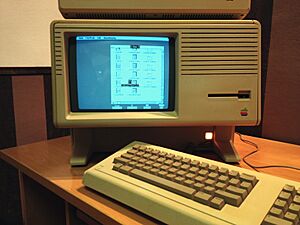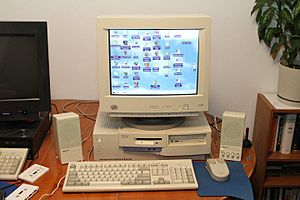History of the graphical user interface facts for kids
Imagine using a computer without a mouse, icons, or menus! That's how computers used to be. The history of the graphical user interface (GUI) is all about how computers learned to show us pictures and buttons we could click, instead of just text. A GUI uses icons (small pictures), menus (lists of choices), and a pointing device like a mouse to help you control the computer. This way of using computers is often called the WIMP system, which stands for "Window, Icon, Menu, and Pointing device."
Over the past 50 years, GUIs have gotten much better, but they still use the same basic ideas. Today, most desktop computers use a mouse and keyboard, laptops have a touchpad, and phones and tablets use a touchscreen.
Contents
- Early Ideas for Computer Graphics
- The 1990s: Computers for Everyone
- Current Trends in GUIs
- See also
Early Ideas for Computer Graphics
Long ago, even before personal computers, some special displays like radar screens used input devices to control information. This was an early step towards GUIs. Some old screens, called CRT screens, even used a light pen to point at things, instead of a mouse.
The idea of having many different windows open at once on a screen came from early systems like the SAGE Project and Ivan Sutherland's Sketchpad.
Douglas Engelbart and the NLS
In the 1960s, a scientist named Douglas Engelbart worked on a project called the oN-Line System (NLS) at SRI International. This system was amazing for its time! It had a mouse-controlled pointer and used multiple windows to work with hypertext (like links on the internet today). Engelbart was inspired by an older idea for an information machine called the memex.
Engelbart showed off his work to the public on December 9, 1968. This famous event is often called "The Mother of All Demos" because it showed so many new computer ideas for the first time.
Xerox PARC's Innovations

Engelbart's ideas greatly influenced the work at Xerox PARC in the early 1970s. Many people from Engelbart's team moved to Xerox PARC.
In 1973, Xerox PARC created the Alto computer. It was the first computer to show the "desktop metaphor" and a full GUI. This meant the screen looked like a desk with papers (files) on it. The Alto wasn't sold to the public, but it was used a lot at Xerox and universities. It had a huge impact on how personal computers were designed later on, especially the Apple Lisa and Macintosh.
The modern WIMP GUI, with its windows, icons, and menus, was first developed at Xerox PARC. In 1975, Xerox engineers showed a GUI that included icons and the first "pop-up menus" (menus that appear when you click something).
In 1981, Xerox released the Star workstation, which used many of PARC's new ideas. Even though it wasn't a big seller, the Star also influenced future computers from companies like Apple and Microsoft.
Quantel Paintbox
The Paintbox was released in 1981 by a company called Quantel. It was a computer made for creating color graphics. It could use a mouse, but it was more designed for graphics tablets. This system was also one of the first to have pop-up menus, which are menus that change depending on what you click.
Apple Lisa and Macintosh
Starting in 1979, the teams at Apple Computer began working on their own GUIs for the Apple Lisa and Macintosh. Some former Xerox PARC employees joined Apple to help.
The Lisa, released in 1983, had a high-quality graphical interface. It was very advanced, even allowing you to run many programs at once. The Macintosh, released in 1984, was simpler and cheaper. It was the first commercially successful computer to use a multi-window interface.
The Macintosh used a "desktop metaphor." Files looked like pieces of paper, and folders looked like file folders. You could even drag files to a trash-can icon to delete them. This made computers much easier for everyone to use.
There's some debate about how much Apple's GUIs were influenced by Xerox PARC. Apple engineers did visit PARC, and some PARC employees moved to Apple. However, Apple added many new ideas, like icons you could move around and drag and drop features for managing files.
In 1984, Apple released a famous TV commercial during the Super Bowl XVIII. It showed the Apple Macintosh as a friendly computer for everyone, very different from the complex business computers of the time.
In 1986, Apple launched the Apple IIGS. This was an advanced version of the popular Apple II computers. It came with a new operating system called Apple GS/OS that had a GUI very similar to the Macintosh.
Visi On
VisiCorp's Visi On was a GUI made for IBM PCs running DOS. It came out in December 1983. Visi On had many features of modern GUIs. It was fully controlled by a mouse, used graphics for both text and pictures, had online help, and let users open many programs in their own windows. However, it didn't have a graphical way to manage files. It also needed an expensive hard drive to work well.
GEM (Graphics Environment Manager)
Digital Research (DRI) created GEM as an extra program for personal computers. GEM worked with existing CP/M and MS-DOS operating systems on business computers like IBM PC compatibles. Because it looked very similar to the Macintosh desktop, Apple sued DRI. They settled, and GEM had to make some changes. This was one of the first "look and feel" lawsuits about GUI design.
GEM became very popular in 1985 when it was built into the Atari TOS operating system for the Atari ST computers. It was also included with other computers like the Amstrad. GEM's popularity faded in the early 1990s as Microsoft Windows 3.0 became more popular.
Amiga Intuition and the Workbench
The Amiga computer was released by Commodore in 1985. It had a GUI called Workbench. Workbench used an internal system called Intuition to handle all the mouse and keyboard actions. Early versions used a blue, orange, white, and black color scheme for good contrast on TVs. Workbench showed folders as "drawers" to fit its "workbench" theme.
Many people called the entire AmigaOS "Workbench." This changed with version 2.0, which gave proper names to the different parts of the operating system.
Amiga users could also start their computer in a command-line interface (CLI), which was a text-based environment without the Workbench GUI. They could then type a command to load the Workbench GUI.
One big difference with the Amiga was its ability to run many programs at the same time (multi-tasking). It also had powerful built-in features for animation and sound. This made the Amiga one of the first "multimedia" computers, years before others.
Acorn BBC Master Compact
Acorn's 8-bit BBC Master Compact computer came with Acorn's first public GUI in 1986. Not many commercial programs were made for this system, even though Acorn claimed many would be available.
Arthur / RISC OS
RISC OS is a series of GUI-based operating systems made for ARM computers. It got its name from the RISC (reduced instruction set computer) design of the ARM processors. This OS was first developed by Acorn Computers for their 1987 Archimedes personal computers. It includes both a command-line interface and a desktop environment with a windowing system.
The first version was called Arthur 1.20, and the next version, Arthur 2, was released as RISC OS 2.
Desktop Features
The WIMP interface in RISC OS uses three mouse buttons: Select, Menu, and Adjust. It has menus that change based on what you click, and you can control how windows are stacked. The Icon bar (like a Dock) holds icons for disk drives, running programs, and other tools. These icons and open windows have their own menus and support drag-and-drop actions.
The GUI focuses on files. The Filer shows what's inside a disk. You can run programs from the Filer, and you can drag files from programs to the Filer to save them. You can also drag files from the Filer into programs to open them.
Programs are stored in special "Application directories" that have an exclamation mark (!) at the beginning of their name. If you double-click one of these directories, it launches the program instead of opening the folder. This makes it easy to install and remove programs by just dragging them.
Files also have "types." RISC OS knows about many file types. If you double-click a file with a known type, it will open the right program to load that file.
MS-DOS File Managers
Early IBM PCs and compatible computers didn't have true graphics. They used a basic text mode display. Because of this, many file manager programs appeared, like Microsoft's DOS Shell. These programs had GUI-like elements such as menus, buttons, and lists with scrollbars, and you could use a mouse pointer. This type of interface was later called a text-based user interface. Many MS-DOS programs, like the QBasic editor, used this style.
Some advanced file managers for MS-DOS could change the look of characters on the screen. This allowed them to show simple, low-resolution icons and graphical elements, including an arrow for the mouse pointer. Popular utility programs like Norton Utilities also used these techniques.
DESQview was a text-mode program from 1985 that let users run multiple DOS programs at the same time in windows. It wasn't a true GUI, but it offered some GUI features like resizable windows and mouse pointing.
Microsoft Windows (Early Versions)
Windows 1.0, a GUI for the MS-DOS operating system, came out in 1985. It wasn't very popular at first. Windows 2.0 followed, but it wasn't until Windows 3.0 launched in 1990 that it became a huge success. Windows 3.0 was based on IBM Common User Access ideas. The GUI had small updates, like Windows 3.11 which added networking. These early 16-bit versions of Windows were replaced by 32-bit versions like Windows 95 and Windows NT in the 1990s.
In 1988, Apple sued Microsoft for copying the look of the Lisa and Macintosh GUI. The lawsuit lasted four years, and most of Apple's claims were denied. Microsoft and Apple eventually settled the matter privately in 1997.
GEOS
GEOS was released in 1986, first for the 8-bit Commodore 64 and then the Apple II. It later became PC/Geos for IBM PC systems. It came with programs like a calendar and word processor. GEOS could run well on simpler computers compared to Windows 3.0. However, its creators made it hard for other companies to develop programs for it, which stopped it from becoming a major competitor.
The X Window System
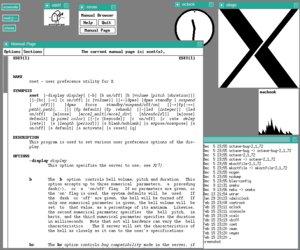
The X Window System (often called X11 or X) is the standard windowing system for Unix computers. It was first released in the mid-1980s. X was created at MIT to let users of new graphics terminals access remote computers, no matter what operating system or hardware those computers used. Because the source code for X was available for free, it became the standard for managing graphics and input on almost all Unix, Linux, and similar operating systems, except for macOS and Android.
X allows you to use programs running on a different computer over a network as if they were on your own computer. This is because X separates the display and input parts of a program from the rest of the program. X is still available today as free software.
The 1990s: Computers for Everyone
In the 1990s, personal computers became very popular in homes and small businesses. This meant many people who weren't computer experts started using them. This created a big market for easy-to-use interfaces, which led to many improvements in GUIs for home computers.
Also, computers got much better at showing many colors, and they had faster processors, better graphics cards, cheaper memory, and much larger storage space. This made it possible to run complex GUIs that looked much nicer.
Windows 95 and Computers in Every Home
After Windows 3.11, Microsoft started working on a new version for regular users. Windows 95 combined Microsoft's old MS-DOS and Windows products. It also had a completely new GUI design. Windows 95 was a huge success and quickly became the most popular operating system ever.
Windows 95 also saw the start of the "browser wars" as the internet became very popular. Windows 95 came with Microsoft's own online service, The Microsoft Network. Later, Microsoft used its strong position in the computer market to push its own web browser, Internet Explorer.
Windows 95 later developed into Windows 98 and Windows ME. Windows ME was the last version based on the old Windows 3.x system. Microsoft also had a separate, more powerful line of Windows called Windows NT, which was a true 32-bit operating system. Windows NT 4.0 looked similar to Windows 95 and included the famous Start button. This line continued with Windows 2000, Windows XP, Windows Vista, and Windows 7.
Mac OS
The Macintosh GUI has been updated many times since 1984, with big changes in System 7 and Mac OS 8. Its biggest change came in 2001 with the "Aqua" interface in Mac OS X. This was a new operating system built on technology from NeXTSTEP, but with the look and feel of the original Mac OS.
macOS uses a technology called Quartz for drawing graphics on the screen. Some features of macOS, like the Dock and smooth window redrawing, came from NeXTSTEP. Other features, like the single menu bar at the top of the screen, came from the old Mac OS. Mac OS X 10.3 added features like Exposé, which makes it easier to find open windows.
Mac OS X 10.4 (2005) added Dashboard (a virtual desktop for small apps) and Spotlight, a powerful search tool for finding files. Later versions like Mac OS X 10.7 (2011) added support for full screen apps.
GUIs Built on the X Window System
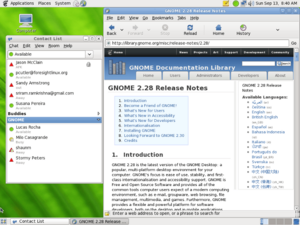
In the early days of X Window, some companies tried to create standard GUIs. Eventually, Motif became popular and was used for the Common Desktop Environment (CDE).
In the late 1990s, the free software community grew a lot, especially around Linux. New graphical desktop environments were created based on the X Window System. These new environments, like KDE Plasma 5, GNOME, and Xfce, focused on giving users a complete and consistent interface. They became more popular than CDE on Unix and Linux systems.
Amiga (Later Versions)
Later versions of the Amiga's Workbench added improvements like support for more colors, context menus, and icons that looked 3D. Some Amiga users preferred other interfaces like Directory Opus Magellan.
Many users also started using improved, third-party GUI engines like Magic User Interface (MUI) and ReAction. These programs made the Amiga Workbench look more modern, with new buttons, 24-bit color icons, wallpapers, and transparency effects, just like modern GUIs.
Today, there are modern versions of Workbench for different Amiga-like operating systems, such as Ambient for MorphOS and Workbench for AmigaOS 4.
OS/2
OS/2 was first developed by Microsoft and IBM to replace DOS. Version 1.0 (1987) had no GUI. Version 1.1 (1988) included Presentation Manager, which looked a lot like the later Windows 3.1. After Microsoft and IBM stopped working together, IBM developed the Workplace Shell (WPS) for OS/2 version 2.0 (1992). This was a very new, object-oriented way of designing GUIs. Microsoft later copied many of these ideas for Windows 95.
NeXTSTEP
The NeXTSTEP user interface was used on NeXT computers. The first major version came out in 1989. One of its most important features was the Dock, which was later used in Mac OS X. NeXTSTEP was also the first GUI to allow you to drag windows around the screen without them looking like outlines.
BeOS
BeOS was an operating system developed by a team led by former Apple executive Jean-Louis Gassée. It was created as an alternative to Mac OS. BeOS used its own special kernel and a completely new GUI, not the X Window System. The developers focused on making it great for multimedia programs. The BeOS GUI still exists today in Haiku, which is an open-source software version of BeOS.
Current Trends in GUIs
Mobile Devices
General Magic is seen as the starting point for modern smartphone GUIs, especially those with touchscreens like the iPhone. In 2007, the iPhone, and later the iPad in 2010, made a new style of interaction popular for multi-touch screens. These devices were big steps forward for mobile devices.
Other portable devices like MP3 players and cell phones have also become big areas for GUIs. Since the mid-2000s, most portable devices have high-resolution screens. Because of this, they have their own famous user interfaces and operating systems. Many communities create their own visual elements for these devices, like icons, menus, and wallpapers. These mobile devices often use "post-WIMP" interfaces, which don't need traditional pointing devices like a mouse.
Because powerful graphics use a lot of battery and create heat, many 3D effects from the early 2000s aren't practical on mobile devices. This has led to simpler, two-dimensional interfaces, like the Metro (Modern) UI first used in Windows 8.
3D User Interfaces
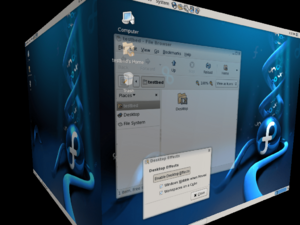
In the early 2000s, graphics cards (GPUs) got much better, leading to more 3D effects in window management. This was based on experiments trying to make GUIs feel more physical and easier to use. New effects included resizing and zooming windows, smooth minimization, transparent windows, and better ways to organize open windows (like virtual desktops and the desktop cube). The BumpTop desktop, for example, combined physical-looking documents with tools for organizing them.
These effects became popular because 3D video cards, mainly used for gaming, could handle complex visuals without slowing down the main computer processor. The graphics card draws the application window and then puts it into a 3D scene.
Examples of 3D user interface software include Xgl and Compiz for Linux, and AIGLX for Red Hat/Fedora. Quartz Extreme for macOS and Windows 7 and Vista's Aero interface also use 3D rendering for effects like shadows and transparency.
Notebook Interface
The notebook interface is widely used in data science and research. Notebooks let users combine text, calculations, and graphs in the same interface. This was not possible with older command-line systems.
Virtual Reality
Virtual reality devices like the Oculus Rift and Sony's PlayStation VR aim to make users feel completely immersed in a virtual world.
See also
- Windowing system
- Graphical user interface
- Text-based user interface
- History of computer icons
- The Mother of All Demos


